|
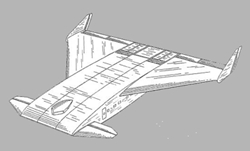 The
Lifting Fuselage Body The
Lifting Fuselage Body
The
Lifting Body or Lifting Fuselage concept dates back
to the earliest days of aeronautics.
The
concept is not to be confused with the Blended Wing
Body that McDonnell Douglas were considering launching
in 1997. In the BWB, the fuselage is not distinct but
blended into the wings.
The
Lifting Fuselage is also distinct from the Flying Wing
designs of Jack Northrop and the Horten Brothers. In
these designs, the centre section of the wing is thickened
to accommodate the payload but there is also no distinct
fuselage as such.
The
Lifting Body or Lifting Fuselage design incorporates
lifting wings and a distinct fuselage which however,
unlike the conventional cylindrical fuselage that is
the almost universal norm in civil aircraft today, is
designed to provide a major part of the lift of the
aircraft.
Induced
Drag of the Lifting Fuselage Design
The
most oft cited criticism of the Lifting Fuselage concept
is that the aspect ratio of the design is very low. This
will therefore lead to high induced drag or drag due to
lift.
However
this criticism is based on a misconception. If you consider
the following two planforms, the conventional wing planform
on the right has a standard high aspect ratio. The wings
by themselves of the lifting fuselage design can be
relatively short; but the fuselage body itself is now
also part of the wing and its width is in effect added
to the entire span of the wing we are considering.
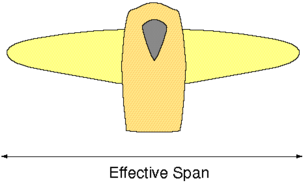 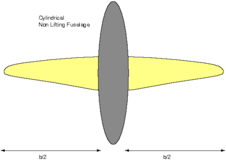
The
high aspect ratio conventional design is supposed to
have lower induced drag because the effect of the wing
tip vortices is proportionally less: as air escapes
from the higher pressure underside of the wing to the
upper surface, it pushes down on the upper surface with
consequent loss of lift. With a high span wing,
the wing tip vortices affect a smaller proportion of
the total surface area of the wing and therefore induced
drag is supposed to be less.
It
is in fact well known that aspect ratio does not necessarily
predict drag. As Daniel Raymer shows (Aircraft
Design: A Conceptual Approach, P20), aspect
ratio cannot be used alone to predict the entire subsonic
L/D ratio because the friction drag is a function of
wetted area, not just wing area as expressed by aspect
ratio.
The
B47 bomber had an aspect ratio of 9.4, while the Avro
Vulcan delta winged bomber designed for the same mission
has an Aspect Ratio of only 3.0; however both aircraft
have a L/D of 17. Both aircraft have about the
same wing span, but the B47 has a narrow chord leading
to lower wing area and higher AR. But the Wetted
Area for the B47 is actually higher (due to the tail
and fuselage) so L/D comes out about the same as the
Vulcan.
In
fact, the B47 has an Swet
to Sref ratio
of 7.9 compared to 3.0 for the Vulcan: the Vulcan
is clearly a far more efficient design from that perspective.
The
Northrop Flying Wing had an Swet to Sref ratio even lower than the Vulcan of about
2.2.
Therefore
as Raymer says, L/D depends primarily on Wetted Aspect Ratio,
defined as wing span squared divided by total wetted
area - not just simply the ordinary Aspect Ratio.
This takes into account both the induced drag due to
lift and the parasite/ skin friction drag.
The
article "The Burnelli Aerofoil Body" by Dr M Watter,
published in "Flight Magazine and the Aircraft Engineer",
December 1935 (available here)
gave a detailed evaluation of the advantages of the
Burnelli lifting fuselage.
The
wing span of a lifting fuselage aircraft could be extended
if required to reduce induced drag: this was not
found to be necessary with the Burnelli lifting fuselage
concept, leading to weight saving and stability advantages.
Straight Sided Fuselage
In
looking at a Burnelli Lifting Fuselage design in comparison
with say the B2 bomber, the Blended Wing Body or the
Irkut 111 below, the Burnelli lifting fuselage
has straight angular sides. The other designs use various
curved blends to merge the top and sides of the fuselage
into the wings.
This
is an important design difference which contributes
to the stability, performance and aerodynamic efficiency
of the lifting fuselage.
One
effect of the sharp angle between the upper or lower
surfaces and the side panels is to prevent cross flow
of air from the higher pressure underside to the lower
pressure upper surface. In other words, it fulfills
the same function as winglets or end plates on the tips
of conventional wings.
This
geometry is conceptually similar to the well known C
Wing of Professor Ilan Kroo at Stanford University.
One C Wing design concept created by Kroo is shown below
- a hybrid blended wing body B747 with non planar wing
tips. Next to it is the McDonnell Douglas BWB with C
Wings added by Kroo.
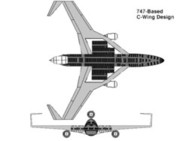 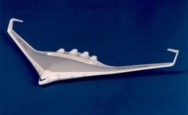
It can be seen that the distinct
straight sided fuselage of the Burnelli concept has another
advantage over the BWB - passenger comfort. The
passenger compartment remains relatively narrow and therefore
passengers sitting in the centre section will not be as
far away from the windows. Height difference between
each half of the cabin is also reduced in turns. This
height difference in the turn is a significant problem
with the spanloader concept.
Advantages
of the Lifting Fuselage Design
The advantages of this concept over conventional
cylindrical fuselage designs are:
- Improved Payload - Range
- Superior Field Performance
- Low Take Off and Landing Speeds
- Lower Manufacturing Cost
- Simpler Structural Analysis
- Vastly Superior Crashworthiness and Survivability
- Improved Fuel Efficiency
Performance Advantage
In
the 1970s, Boeing proposed to launch an aircraft that
would have been called the Boeing 754. This was
a classic lifting fuselage design. It was cancelled
in favour of the B767. The table below (adapted
from the Burnelli website) compares the two designs.
|
OEW
|
Max Payload
|
MZFW
|
Max Fuel
|
MTOW
|
B754
|
159,600
|
160,600
|
320,200
|
143,375
|
363,900
|
B767
|
179,580
|
72,770
|
253,000
|
112,725
|
335,000
|
The Annual Report of the cargo
airline Cargolux for 1975 showed on its front cover
an artist's concept of the 754 front loading cargo through
cavernous cargo doors. Cargolux intended to be
a launch customer for the aircraft.
Like
many other aerospace technology innovations, the Boeing
754 was abandoned in favour of the inferior conventional
approach as we are still seeing with the A380 and 787
today.
Crashworthiness
Notwithstanding
all the other advantages, the case for the Burnelli
lifting fuselage design is overwhelming based on safety
grounds alone.
In
1935 a new Burnelli UB14 executive aircraft was being
delivered to a customer. On arrival at Newark it tipped
to one side and the wing tip caught the ground at 135mph.
The aircraft cartwheeled down the runway before coming
to rest with the main fuselage and cabin structure intact.
Everyone on board survived uninjured. There was no post
crash fire. The cause of the crash was incorrect
rigging of an aileron.
This
post-crash scenario is unimaginable with a conventional
cylindrical fuselage aircraft. The structure of a cylinder
is such that it will always crumple or buckle when subjected
to a compressive or shear load. In aircraft crashes
we frequently see the fuselage break apart at the joints
between the different sections - where different fuselage
sections were manufactured as individual units before
joining.
Even
in the straightforward case of a commercial aircraft
running off the end of the runway at relatively low
speed, the fuselage frequently fails to maintain structural
integrity and breaks apart.
There
is simply no comparison with the structural rigidity
and design philosophy of the modern automobile. In the
30 years since the late 1960s in which cars have become
rigorously designed for crashworthiness and passenger
survivability, civil aircraft structural design has
not changed at all. If anything, modern aircraft may
be less crashworthy due to their reduction in weight,
use of composites and possible composite associated
health hazards.
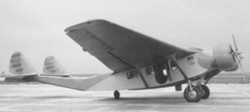 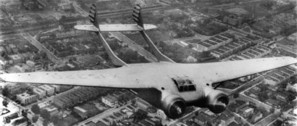
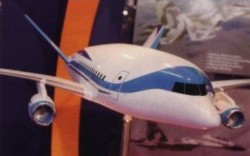 Irkut
111 Irkut
111
The Russian aircraft manufacturer Irkut presented a
"wide body fuselage" 100 seater aircraft at Le Bourget
in 2003.
Unlike the Burnelli designs, the fuselage is not designed
as a lifting surface.
This would be an interesting
candidate for CWD analysis.
Links and
Further Information
More
information on the Burnelli Lifting Fuselage concept
can be found here.
Download AIAA 2003-0292 "The Contributions of Vincent Justus Burnelli" by
Richard M. Wood
|
